Part 2 of the series The Good Life
Find Part 1, What is a Balanced Diet? and the Go Dotty! food counter here>>
Many nutritionists recommend that we should aim to divide out daily calorie allowance into three meals of roughly equal scale and five snacks. So, for an average woman aiming to consume about 2000 calories each day, that would mean approximately 500 calories for each main meal and 500 left over for snacks. I’d also recommend breaking down the 500-calorie breakfast allowance into five approximately 100 calorie portions.
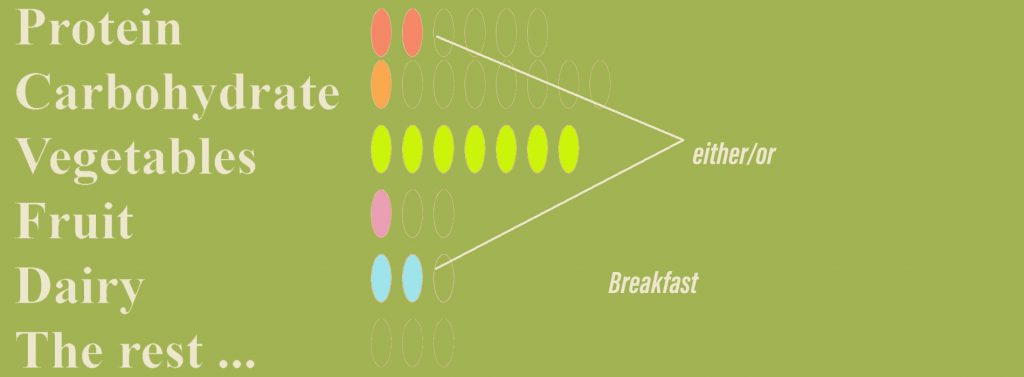
Why I recommend fruit, protein and carbohydrate for breakfast?
The answer is in the word break-fast. During the night, our body switches to fasting mode. It is good to fast overnight while we are resting, but once we wake up, we start using energy at a much faster rate. First, we need a quick hit of fast release carbohydrate to get us going. Fruit offers the best option, because it is also packed with vitamins, especially vitamin C which is the vitamin that helps strengthen immunity.
A good breakfast ought to provide nutrition for the whole of the morning. That’s where protein and carbohydrate come in. Protein keeps us feeling full for a long time and kick-starts the daily processes of life. Wholemeal keeps us regular and the slow release carbohydrate in cereals and grains will boost our metabolism right through to lunch time.
The final ingredient is liquid. A caffeine hit is no bad thing, but make sure you’re getting enough H2O. That means tea, a long coffee, milk or watery fruits like melon and tomatoes. Go easy on the fruit juice. A 500ml glass of proprietary orange juice contains seven whole oranges worth of sugar that have been nicely macerated for you, making their sugars rather too easy to ingest all at once. The sugar content of orange juice, almost as high in free sugars as Coca-cola [i], will rot your teeth and the vitamin C has probably long-since been degraded. Instead try a whole orange, juiced by hand.
Should we eat breakfast?
Many people would contend that breakfast is the most important meal of the day. We now have breakfast clubs in schools. Teachers noticed that children who ate breakfast had better concentration [ii]. You might think that adults are no different. But in fact, the evidence is conflicting. However, we do know that during middle age our digestive processes gradually slow down and become less efficient. This progressive change is unique in each of us. If you notice you are experiencing symptoms, going back to eating a good breakfast might help. In general, it becomes more and more advisable, as we age, to eat smaller, more regular meals.
The Full English
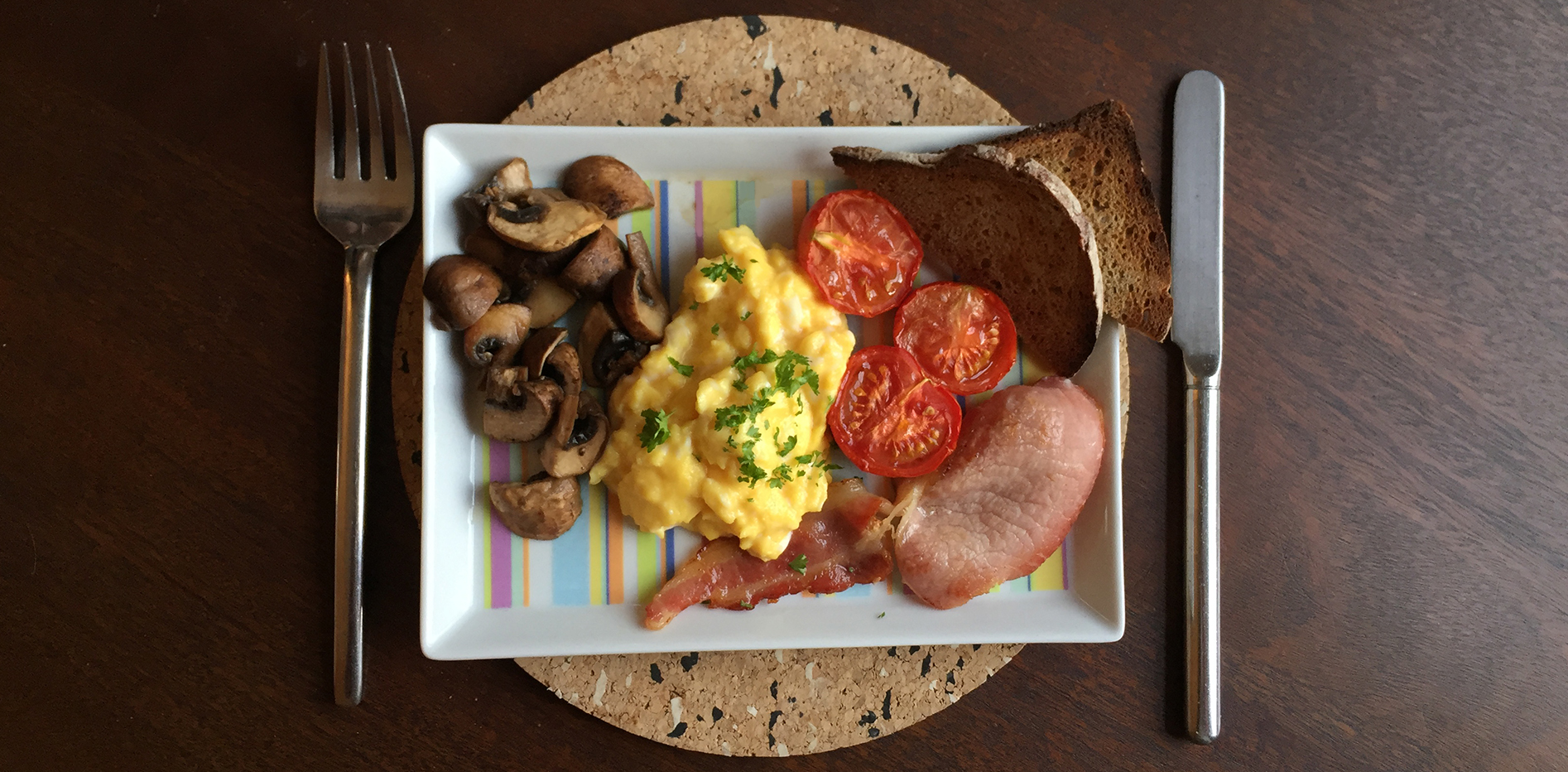
An old-fashioned fried breakfast isn’t so good for us, but we can still enjoy a fantastic English breakfast without ruining our healthy diet. This recipe simply changes the balance of fried foods to baked or sautéed. Chop and change as you like. One day I might have simple eggs and tomato, with perhaps an extra slice of toast and marmalade. Tiny modifications to the cooking technique make a big difference to the nutritional balance. We give our B&B guests this breakfast every day. Where’s the fruit, you might ask. The tomato is the low sugar/high nutrition fruit in this one. But you could also add a small glass of juice from one freshly squeezed orange, a fresh fruit salad, or a half a grapefruit. They all count as one portion.
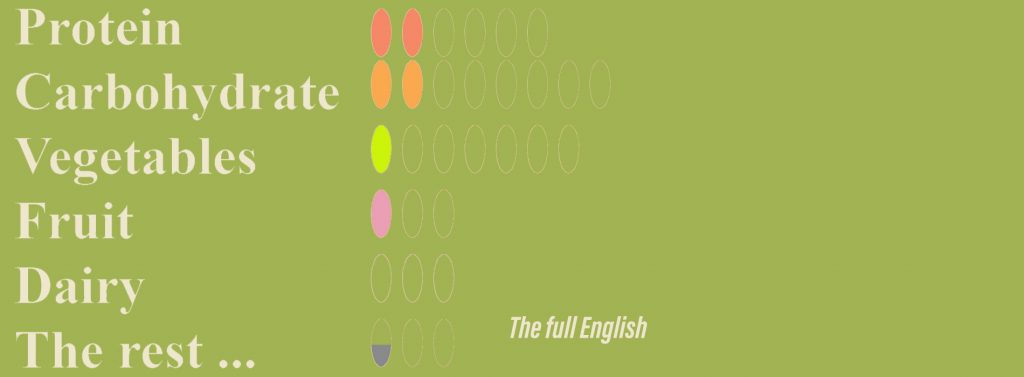
490 calories, 20-21g protein, 8-9g fibre. Note that bacon as a fatty protein, not a lean protein, counts as half a portion of ‘the rest’.
Method:
- 2 organic, free range eggs – scrambled in minimal butter, sprinkle a few bay leaves or parsley on top if you have any. (150calories) (protein 12g)
- 2 slices 100% wholemeal toast – with a tiny bit of butter (200 calories)(protein 6g) (fibre 6g)
- 1 or 2 tomatoes baked in their skins – halve the tomatoes, place face-up on an over proof dish, sprinkle with sea salt and dry bake in a low oven for 1 hour, or microwave, uncovered, for 1 minute (the oven baking makes a far tastier dish)(40 calories)(fibre 2g)
- Handful of fresh mushrooms stewed in 1 tsp olive oil or butter, and 1 tbs water. Season, add freshly grated nutmeg and a drop or two of tamari sauce (50 calories).
- I small rasher(8g) of grilled or fried bacon, (50 calories) (protein 3g)
OR IF PREFERRED - Mini veggi sausage, such as Quorn cocktail sausage – fried or grilled (50 calories) (protein 2g) (<1g fibre)
Porridge
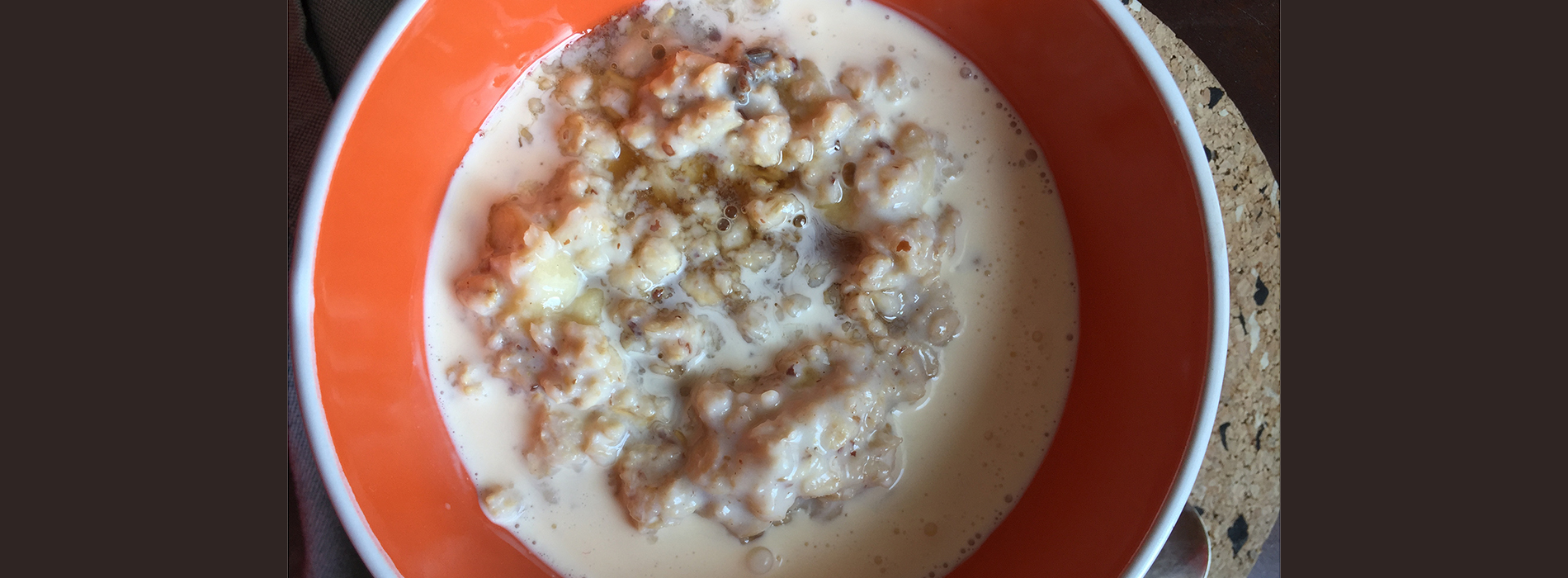
On a winter morning you need something substantial inside you. Get off to a good start with this luxuriously filling and warming porridge. The small amount of maple syrup will help you get going on a cold morning and will not derail your healthy diet, even though nutritionally honey isn’t much different to granulated sugar. But then, a sprinkling of sugar on your porridge wouldn’t be a sin either!
This is my favourite breakfast. I use Irish organic jumbo rolled oats, not a porridge mix. I have discovered that I don’t need the heavily ground-up ‘porridge’ oats in order to achieve a soft consistency. The secret of this dish is to leave it cooking, ever so gently, for about ten minutes. This gives time for the oats to absorb the milk and creates a beautifully creamy mixture. In this recipe I add linseeds, to increase the fibre content, and four or five lavender seeds per person, to add quite a heady perfumed flavour. Don’t be afraid to use full milk. If ever there were a dish to call ambrosia, the ancient Greek term for the elixir of life, then this porridge would be it. To me it tastes very sub-ambrosial if I’m given porridge make with skimmed milk.
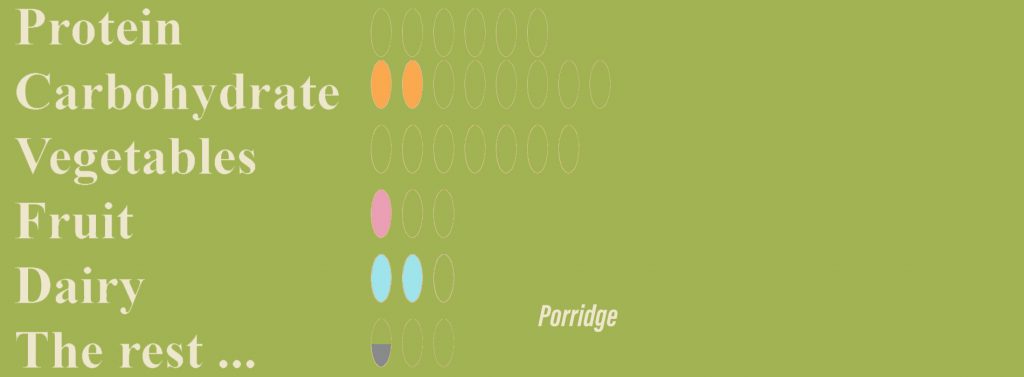
Ingredients for one portion:
- 50g jumbo oats (190 calories) (protein 5.5g) (fibre 3g)
- 200ml full cream milk (calories 130) (protein 7g) (calcium 250mg)
- A sprinkle of lavender seeds – three or four will do, they are very strong tasting
- 1 tablespoon, 7g linseeds (calories 40)(protein 1g) (fibre 2g)
- 1 medium banana – sliced (100 calories) (fibre 3g)
- 1 tablespoonful (13.5g) of honey or maple syrup (50 calories)
Method:
- Grind the linseeds in a coffee grinder or pestle and mortar. Don’t buy ground linseeds as they go off very quickly. But whole linseeds go right through you. In order to be effective, the seeds must be ground or soaked. They receive both treatments in this dish.
- Place all ingredients except the honey or syrup into a thick-bottomed pan and bring to the boil, just for an instance.
- As soon as you see bubbles as the mixture comes up to the boil, turn the heat right down. Put the lid on. Leave the pan on the lowest setting your hob will offer, for ten minutes. The aim is to steep the porridge, not to boil it. Until you get used to this recipe on your hob, check occasionally to make sure it isn’t burning. Once you know the setting that works for you, the mixture can be safely left unwatched for the entire cooking time.
- After ten minutes the mixture will be rich and creamy and should still be very warm. You may re-heat it a little if you like or add more milk if it seems too thick. Turn the mixture into a large bowl and garnish with honey or maple syrup.
I use raw milk and thus heat the milk very cautiously in order to retain the beneficial microbes that fresh, raw milk contains. I also add cold milk to the bowl to replace any microbes that gentle cooking might have damaged. The sweetener I choose complements the natural microbes in milk. Maple syrup and honey contain prebiotic carbohydrates and probiotic bacteria that feed the digestive system, making healthy bacteria and improving our immunity [iii]. However pasteurised milk doesn’t contain many microbes at all. You could add a spoonful of live yoghurt to the mixture if you’re using pasteurised milk.
Can breakfast help with weight loss?
When we are on a diet, hunger between meals can be a problem. Stock up at breakfast time with good food and you’ll find that you have the whole day ahead to break that food down into useable nutrients. For most of us, breakfast is the meal that we can control most easily, in a way that we can’t control canteen lunches or fancy dinners out. Many of my clients try to eat as little as possible at breakfast, saving their calories until the evening. This doesn’t work. I suggest that you try to get used to eating a little in the morning. You’ll soon start to look forward to breaking the night-time fast.
But there really isn’t any good evidence that missing any meal is bad for us. As a rule, I recommend eating a regular breakfast, but there are exceptions. Missing breakfast once in a while can be an easy way of making-up for a few days of over-indulgence. There’s a catch to missing breakfast though. If we decide to extend the morning fast, we must keep on the move until lunch-time. That means walking, sport, strenuous gardening or serious shopping. If we fast and lounge, all we are doing is lowering the metabolism and not shedding any fat [iv].
Can breakfast help with weight loss maintenance?
It might. When we look at populations of people who have lost weight and maintained their weight loss, we find that about three quarters of them report eating breakfast every day of the week. Only 4% report never eating breakfast. The typical breakfast is cereal and fruit. However, I think we should treat this result with a little bit of caution. Self-reported benefits are not always reliable. It may be that it isn’t the regular breakfasts, but the settled and regular nature of these people’s lives that make a difference. It is very difficult to maintain a healthy lifestyle when our lives become topsy-turvy[v].
PROGRAMME
Find other related posts here.
20 December – Commensality (celebrations, parties and eating with friends)
27 December – The New You
[i] Colas are approximately 10% free sugar, orange juice is 8% (by weight). Free sugar is defined as all monosaccharides ( eg fructose or fruit sugars) and disaccharides (eg sucrose or table sugars) that are added to foods by the manufacturer, cook or consumer, plus sugars naturally present in honey, syrups and unsweetened fruit juices. The sugars naturally present in milk and milk products (lactose) and the sugars in the cellular structure of foods don’t count. Government recommendations for adults are no more that 30g/day of free sugars ie about 7 teaspoons.
[ii] Lundqvist, M. & Vogel, N. E. Effects of Eating Breakfast on children and adolescents: A systematic review of potentially relevant outcomes in economic evaluations. 1, 1–15 (2019).
[iii] Mohan, A., Quek, S.-Y., Gutierrez-Maddox, N., Gao, Y. & Shu, Q. Effect of honey in improving the gut microbial balance. Food Qual. Saf. 2017, 107–115 (2017).
[iv] Betts, J. A., Chowdhury, E. A., Gonzalez, J. T. & Richardson, J. D. Is breakfast the most important meal of the day ? Conference on ‘ Roles of sleep and circadian rhythms in the origin and nutritional management of obesity and metabolic disease ’ Cuthbertson Medal Lecture IsTaha, Z., & Rashed, A. S. (2017). The Effect of . 464–474 (2016). doi:10.1017/S0029665116000318
[v] Wyatt, H. R. et al. Long-term weight loss and breakfast in subjects in the National Weight Control Registry. Obes. Res. 10, 78–82 (2002).
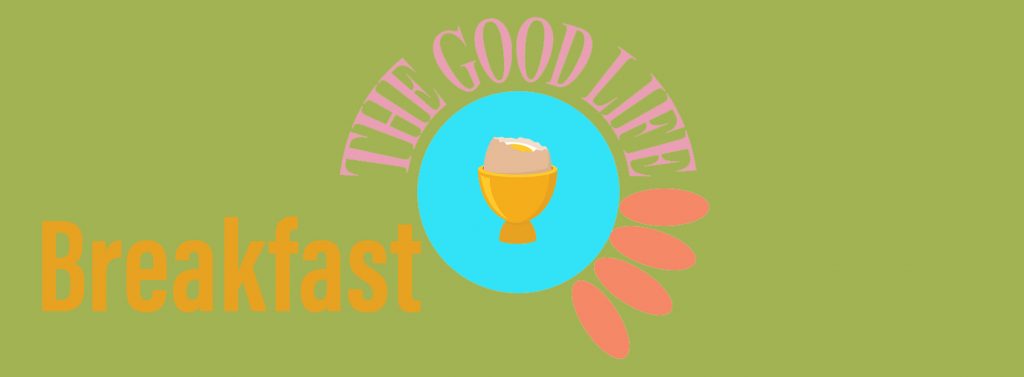
Pingback: Regain your appetite for life | Say Tomato!
Pingback: Learn the art of smart snacking | Say Tomato!
Pingback: Celebrations, parties and eating with friends | Say Tomato!